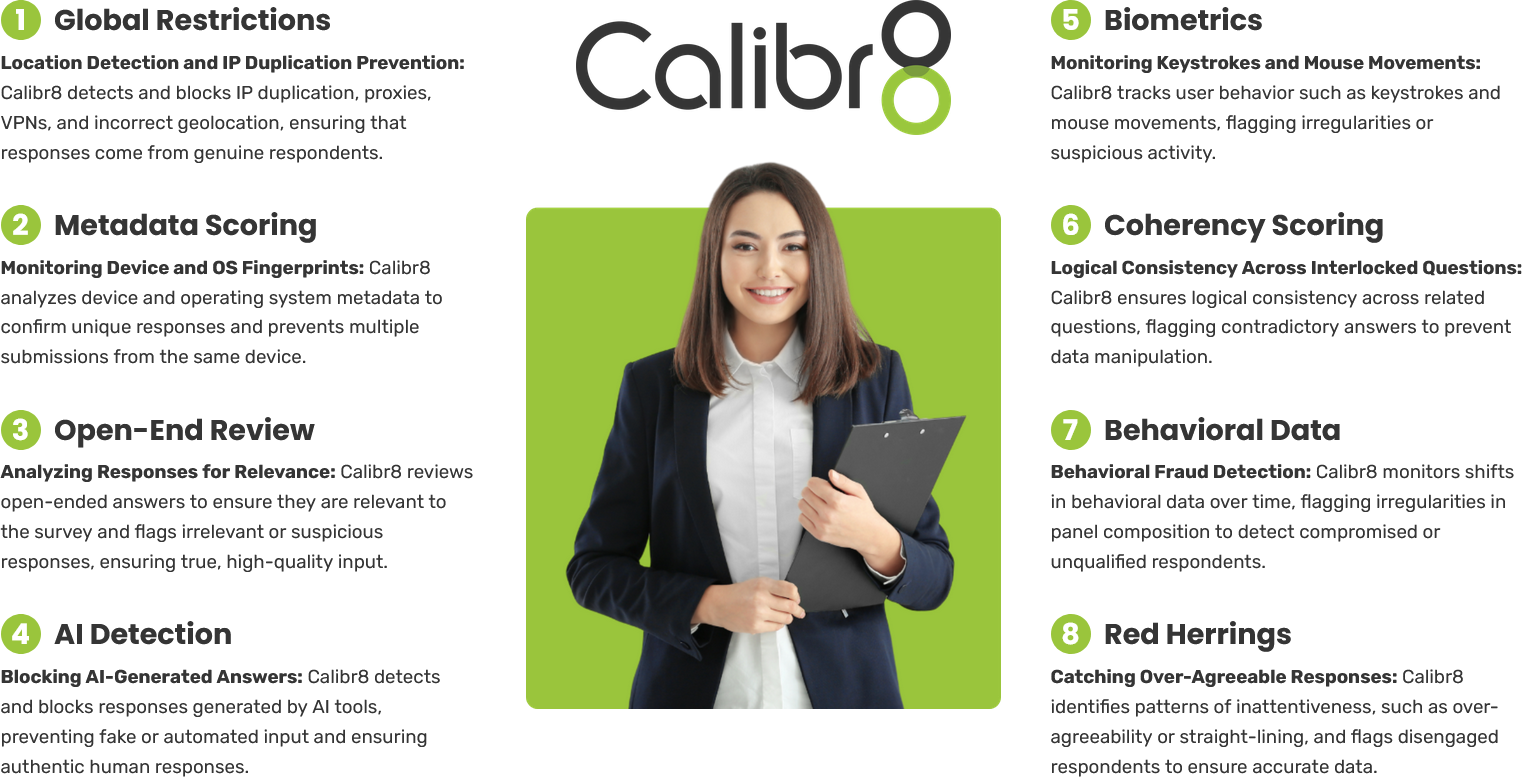Read time: 14 mins
Brand tracking studies represent the backbone of strategic marketing decisions for companies worldwide. These longitudinal research projects measure consumer sentiment, track the effectiveness of advertising, and monitor competitive positioning across multiple waves of data collection. However, the research industry faces an unprecedented challenge that threatens the reliability of these critical insights. Sample quality concerns have reached a tipping point, with awareness levels varying by as much as 25 percentage points and brand ratings fluctuating by 20 percentage points based solely on sample provider selection. This variance isn’t just a statistical inconvenience—it represents millions of dollars in potentially misguided marketing investments and strategic missteps.
Key Takeaways
- Essential for long-term strategy — Brand tracking provides ongoing, reliable insights into consumer perceptions and competitive positioning over time.
- Measures marketing effectiveness — Tracks how campaigns influence awareness, preference, and loyalty across multiple data waves.
- Guides smarter decisions — Identifies strengths, weaknesses, and emerging trends so companies can adapt strategies proactively.
The problem becomes exponentially more complex when applied to longitudinal studies. Unlike one-time research projects, where quality issues might be contained to a single data point, brand trackers amplify these concerns across multiple waves, creating cascading effects that can render entire tracking programs unreliable. Research directors find themselves caught between the pressure to deliver consistent, actionable insights and the reality of an increasingly fragmented sample ecosystem. The solution lies not in accepting these quality variations as inevitable, but in implementing comprehensive quality management frameworks specifically designed for addressing longitudinal research challenges.
The Stakes: Why Data Quality Matters More in Brand Tracking
Longitudinal studies face unique vulnerabilities that don’t exist in single-wave research projects. Panel fatigue creates systematic response patterns as participants become conditioned to survey formats and question types over time, while sample attrition compounds these issues as participants who drop out often exhibit different characteristics than those who remain. These conditioning effects can artificially inflate or deflate key metrics, making it difficult to distinguish between genuine market changes and methodological artifacts. The challenge becomes particularly complex because the most engaged participants—those most likely to complete multiple waves—may also be those most susceptible to conditioning effects, creating systematic bias that accumulates over time.
When brand tracking data suggests declining awareness levels, marketing teams might increase advertising spend unnecessarily if the decline stems from sample quality rather than genuine market shifts. Conversely, artificially inflated satisfaction scores lead to reduced customer experience investments at precisely the moment when competitive pressures demand increased attention. Research directors understand these stakes intimately, which explains why they prioritize vendors with proven track records in longitudinal data quality management over those offering lower-cost alternatives.
Four Cornerstones of Longitudinal Data Quality Management
Continuous Quality Monitoring
Real-time quality assessment represents a fundamental shift from traditional post-collection quality reviews to proactive monitoring throughout the data collection lifecycle. This approach identifies problematic patterns before they compromise entire waves of data, allowing for immediate corrective action rather than retrospective damage control. Advanced monitoring systems track response patterns, completion rates, and engagement metrics across multiple dimensions, creating comprehensive quality profiles that evolve with each wave of data collection.
The most effective monitoring systems establish quality benchmarks specific to each tracking study, recognizing that different brands and categories exhibit distinct baseline patterns. These benchmarks account for seasonal variations, category-specific response behaviors, and historical performance trends that might otherwise trigger false alarms. By maintaining study-specific quality thresholds, monitoring systems can distinguish between legitimate market shifts and quality degradation, providing research teams with the confidence to act on their findings.
Continuous monitoring also enables dynamic sample management, allowing research teams to adjust recruitment strategies mid-field based on emerging quality indicators. This flexibility proves particularly valuable when dealing with hard-to-reach demographics or during periods of market volatility when response patterns might shift unexpectedly. The ability to make real-time adjustments without compromising study integrity represents a significant competitive advantage for research operations teams working under tight deadlines and budget constraints.
Strategic Sample Calibration
Automated sample calibration extends beyond traditional demographic quotas to encompass behavioral and attitudinal characteristics that influence the performance of longitudinal studies. This sophisticated approach recognizes that maintaining sample representativeness requires continuous adjustment as market conditions evolve and participant pools shift over time. Calibration systems analyze multiple data points simultaneously, including response quality indicators, engagement metrics, and demographic stability, to ensure that each wave maintains comparability with previous data collection periods.
Strategic replacement protocols maintain study integrity while accommodating participant turnover through sophisticated matching algorithms that consider response patterns, engagement levels, and quality indicators, rather than relying on simple demographic substitution. This approach prevents the gradual degradation of sample quality that typically occurs when replacement participants exhibit characteristics different from those of the original study population. Custom sample blending represents the most advanced application of this approach, combining multiple sample sources to create optimized participant pools that compensate for individual provider limitations while maintaining longitudinal consistency.
Advanced Fraud Detection and Prevention
The landscape of survey fraud has evolved significantly in recent years, with sophisticated bad actors developing increasingly complex methods to circumvent traditional detection systems. Longitudinal studies face particular vulnerability because fraudulent participants often exhibit patterns that become apparent only across multiple waves of data collection. Advanced fraud detection systems employ multiple verification layers—including device fingerprinting, IP tracking, behavioral analysis, and AI-powered validation of open-ended responses—to identify and eliminate problematic responses before they compromise study integrity.
Response pattern analysis provides another critical detection mechanism, identifying participants who exhibit systematic response behaviors such as excessive straightlining, inconsistent responses to validation questions, or completion times that fall outside normal ranges. By analyzing these indicators across multiple waves, detection systems can identify participants whose long-term engagement patterns suggest quality issues that might not be apparent in single-wave analysis. The technology continuously learns from new fraud patterns, adapting its detection capabilities to stay ahead of evolving threats to data integrity.
Comprehensive Reporting and Actionable Insights
Wave-over-wave quality reporting transforms raw quality metrics into strategic insights, enabling informed decision-making about sample management and study optimization. These reports go beyond basic completion rates and demographic breakdowns to provide detailed analyses of quality trends, demographic shifts, and their implications for longitudinal analysis, as well as recommended actions for addressing identified issues. The reporting framework presents complex quality data in formats that research directors can easily interpret and act upon, bridging the gap between technical quality metrics and business decision-making.
The most effective reporting systems provide actionable recommendations based on quality analysis, suggesting specific interventions such as adjustments to sample composition, modifications to fieldwork timing, or refinements to screening criteria that optimize quality while maintaining longitudinal comparability. This integration of recommendations with quality reporting creates a comprehensive quality management framework that supports both tactical execution and strategic planning, helping research teams understand whether observed changes reflect genuine market trends or methodological artifacts.
Technology in Action: The Calibr8 Advantage
Calibr8 uses eight advanced tools for comprehensive fraud detection. Here’s how each tool works to ensure accurate and reliable data.

Calibr8 represents an integrated approach to longitudinal quality management that addresses each of the four cornerstones through automated, intelligent sample oversight. The platform evaluates every respondent through a comprehensive analysis of metadata, behavioral patterns, and response quality indicators, ensuring consistent standards across all sample sources and collection waves. This systematic approach eliminates the variability that typically occurs when multiple sample providers operate under different quality standards or when manual quality review processes introduce human inconsistency.
The automated calibration features adapt sample characteristics based on predefined criteria while maintaining the flexibility to accommodate market changes and study-specific requirements. This automation reduces the manual oversight burden on research operations teams while ensuring that quality standards remain consistent across extended tracking periods. The platform’s ability to make real-time adjustments based on emerging quality indicators provides research teams with the agility needed to maintain study integrity without sacrificing delivery timelines or budget constraints.
Building Trust Through Consistency
The competitive advantage of reliable tracking data extends far beyond methodological considerations to encompass the fundamental trust relationship between research providers and their clients. When brand tracking studies deliver consistent, high-quality insights across multiple waves, they enable marketing teams to make strategic decisions with confidence, knowing that observed changes reflect genuine market dynamics rather than methodological artifacts. This reliability becomes particularly crucial during periods of market volatility when accurate trend identification can mean the difference between successful adaptation and strategic missteps.
Quality sample management transforms brand tracking from a necessary reporting function into a strategic competitive advantage that drives business growth and market success. With a finger on the pulse of innovation in the data quality space, Steve Male states, “Research directors who partner with providers capable of delivering consistent, high-quality longitudinal data position their organizations to respond more effectively to market opportunities while avoiding the costly mistakes that result from unreliable insights.” The truth is that investment in sophisticated quality management systems pays dividends through improved decision-making, reduced risks for research projects, and enhanced credibility with internal stakeholders who depend on tracking data for strategic planning.
The future of brand tracking lies in the hands of research providers who understand that sample quality represents not just a methodological requirement but a fundamental business imperative that determines the value and impact of longitudinal research programs. As sample quality concerns continue to challenge the industry, the organizations that invest in comprehensive quality management frameworks will establish themselves as trusted partners capable of delivering the reliable insights that drive marketing success in an increasingly complex marketplace.




